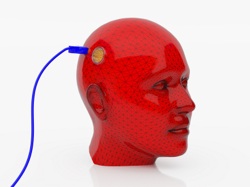A magazine where the digital world meets the real world.
On the web
- Home
- Browse by date
- Browse by topic
- Enter the maze
- Follow our blog
- Follow us on Twitter
- Resources for teachers
- Subscribe
In print
What is cs4fn?
- About us
- Contact us
- Partners
- Privacy and cookies
- Copyright and contributions
- Links to other fun sites
- Complete our questionnaire, give us feedback
Search:
Go fly a kite

What greener hobby than flying a kite? It doesn’t use up batteries: all the fun comes from natural energy sources. Better still, it’s really exhilarating and, with a big kite, your arms might even feel like they’ve had a good workout afterwards. If a team from the University of Sussex get their way, future kites might soon be giving robot brains a workout too.
Pain with gain
There is lots of energy in the wind. A large kite can easily drag a person along the ground – which is why there are now sports like Kiteboarding and Kitesurfing. You could just use that energy for enjoyment, but why not harvest it instead? The idea of wind energy isn’t new of course. Centuries ago windmills drove the original energy revolution and their modern counterpart the wind turbine is now touted as one way to wean us off oil.
Wind turbines aren’t the only way to generate energy from wind though and actually they are at a bit of a disadvantage. Never mind that local people always want them put somewhere else, no matter where they go they are stuck down at ground level. Down there the wind speeds are low. Also, close to the ground you can’t guarantee the supply: when the wind drops it’s bye-bye energy. Go higher though and there is far stronger and far more stable wind energy to tap. All you need is a kite with a very long string!
Let it all out
The basic idea of using a kite to generate energy is to let the wind unwind the string. That drives a generator as it goes higher. Then when you run out of string you pull the kite back in and start again. If you can pull the kite back to where it started using less energy than you generated, then your green energy system is off the ground (so to speak). Google think the idea has enough potential to have poured 10 million dollars into one company developing the idea.
Even though the science has been known for a long time, turning that into an industrial strength prototype isn’t easy. The big problem is not how to build the kites but how to control them to catch as much energy as possible. You can’t just get a kid to hold the kite after all. Enter some robot brains.

Evolve a new brain
Allister Furey and Inman Harvey from the University of Sussex have been exploring how techniques used to develop brains for robots can be used to control energy harvesting kites efficiently. Not only are they giving the kites artificial brains, they’re giving them brains that evolve!
The pressures on animals that make their species become faster, stronger, or quieter over many generations of children is called an evolutionary pressure. If you can create an artificial evolutionary pressure – building it into what computer scientists call a ‘genetic algorithm’ – you can use it to drive changes in man-made systems too. That’s what the Sussex team created. Instead of trying to design the best brain to control their kite themselves, they were going to let evolution design it for them.
Mutate to survive
They started by designing a very simple kite controller, which they then released into the ‘wild’ of their genetic algorithm to see how it got on. To ‘survive’ these artificial brains needed to get the most energy from the tugs and lulls of the wind over a period of time. Those that did best were allowed to have ‘children’ – new controllers that were random mutations of the original (that is all you are – a mutated version of your parents!) All the children were then tested anew spawning their own children. This went on and on, generation after generation. Over time the evolving brains got better and better at controlling the kites, even starting to fly them in figure-of-8 patterns. That’s not only fancy kite-flying, it’s a pattern that scientists know is a good way to catch the energy of the wind. The kite controllers had evolved, just like many real creatures have, to efficiently harvest the energy sources available to them. That may even give us a clue to the future of artificial life: computerised creatures that can harvest energy from their environment to sustain themselves just like all animals do.
Going out to play
So far the controllers have only been playing with virtual kites in simulations, but one day soon they will be allowed out to play in the real world. When the time comes, the kite-flying computers may have all the fun but we’ll have a new source of green energy.


